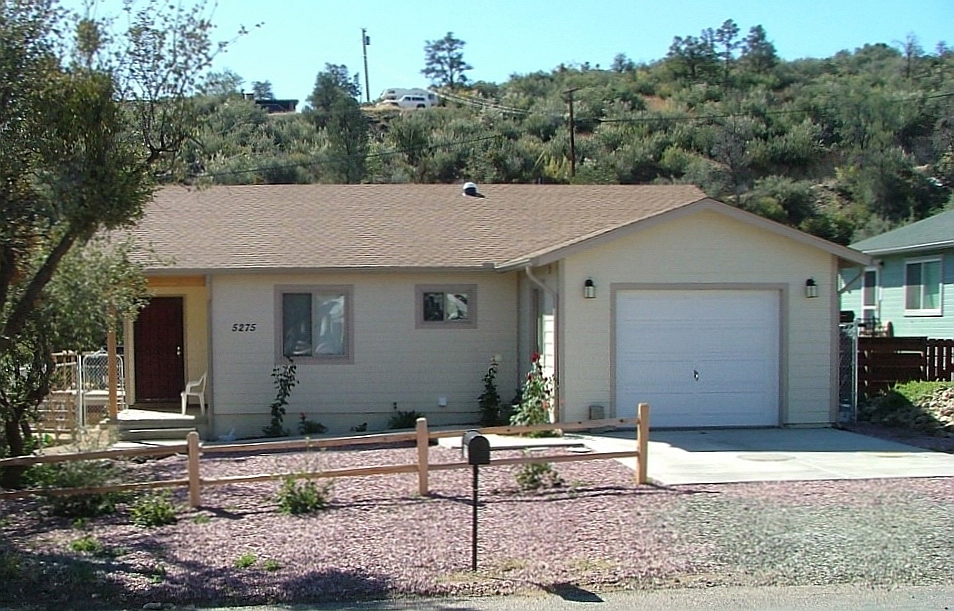
Image Credit: Tony Grahame
Image Credit: Tony Grahame Sprayed polyurethane foam and rigid XPS foam with taped seams are very effective as insulation and air barriers.
Image Credit: Tony Grahame Engineered trusses and advanced-framing methods make room for plenty of insulation and use less materials than a typical house. All headers in the home are insulated with XPS foam.
Image Credit: Tony Grahame The home gets most of its domestic hot water from a flat plate solar collector.
Image Credit: Tony Grahame Image Credit: Toshi Woudenberg TOP 25% OF AMERICAN HOUSES: 40.8 MMBtu/year. There's nothing particularly complicated about this home - it's just built very well. The large crew of student laborers from the Yavapai College Residential Building Technology program may have made it easier to find every possible air leak in this thoroughly sealed, mechanically ventilated home. But that's not to say that a well informed, concientious contractor wouldn't be just as succesful at building an affordable, energy efficient home.
#Typical Looking, Uncommonly Efficient and Healthy
This rather typical-looking single-story ranch house is very uncommon in a lot of ways. It’s super energy-efficient, it has superior indoor air quality compared to most new houses, and it cost $55/square foot to build.
That it was so cheap to build flies in the face of conventional thinking about green building. How was this done? Tradeoffs. Fewer studs means more room for insulation. Roof overhangs and quality windows mean a smaller AC system. An unvented roof means the AC and ducts can go in the attic.
Make the site work without overdoing it
The cost savings began with the site: a substandard lot (thanks to flood-plain issues) was engineered to bring it up to code. While there was a high level of engineering involved, the lot was kept localized as much as possible — many existing trees and shrubs were spared. No toxic pesticides were sprayed before construction, and the house is oriented along an east-west axis to maximize southern exposure for day lighting, passive warming in winter, and solar collectors on the roof that heat the water for free.
Standard green details done well
Advanced framing, exterior foam insulation, and an unvented roof yielded an extremely tight envelope — .63 ACH, at no “extra” cost. A smart plumbing layout cuts the amount of time it takes for hot water to reach a tap, which saves water. Many of the techniques used in the design and construction of this house are old news: insulating a slab keeps it warm and dry; foam sheathing on the outside keeps the framing warm and dry, so mold isn’t likely to gain a foothold; and better windows are worth it.
Weekly Newsletter
Get building science and energy efficiency advice, plus special offers, in your inbox.
Lessons Learned
Because of the small lot size, a standard septic leach field was not feasible for this project. Tony Grahame, director of Yavapai College's Residential Building Technology program, solved this problem with the Geotextile Sand Filter system made by Eljen.
A plastic grid covered in a special drainage fabric allows for more surface area, more volume, and more air infiltration than the typical bed of gravel. The result is that you get a leach field that will likely perform better while taking up 50% less space. Using this system was the only way to build a home on this particular site, but it would be valuable to anyone trying to keep site disturbances to a minimum.
General Specs and Team
| Location: | Prescott, AZ |
|---|---|
| Bedrooms: | 3 |
| Bathrooms: | 2 |
| Living Space: | 1189 |
| Cost: | 55 |
| Additional Notes: | Student labor was free |
Builder: Yavapai College Residential Building Technology program; Tony Grahame, Director.
Architect/designer: Prescott-area Habitat for Humanity
Construction
Foundation: slab on grade with XPS foam at edge (R-5)
Walls: 2x4 @ 24 in. o.c.; 1-in. XPS foam and dense-pack cellulose (R-19 total)
Roof: raised heel trusses; 8 in. foam sprayed to underside of roof deck (R-32, unvented).
Windows: double-pane, low-e, argon-filled (SHGC, .33 to .35; U factor, 0.32 to 0.35, R-3)
Garage: attached; insulated and sealed from living space
Energy
- Roof overhangs optimally sized for window heights to allow summer window shading and winter sun entry for passive solar heating.
- Energy Star interior and exterior lighting package with CFL bulbs
- Extremely tight building envelope (103 cfm @ 50 pascals equivalent to 0.63 ACH)
- Energy Star appliances
- HVAC requirements calculated and sized appropriately
- Programmable thermostats
- Sealed ductwork; duct blaster leakage measured 14 cfm @ 25 Pascals
Energy Specs
Heating/cooling: 14-SEER Energy Star AC system; 40,000 BTU direct-vent gas furnace (92.0 AFUE)
Water heating: solar domestic hot-water system, 40.9 sq. ft. flat-plate collector, 80-gal. storage tank with electric backup
HERS rating: 57 (5 stars)
Annual energy use: 40.8 MMBtu
Water Efficiency
- Low-flow toilets, faucets, and showerheads
- Water-conserving dishwasher
- All hot water taps within 30 ft. of hot-water storage tank
Indoor Air Quality
- Balanced whole-house ventilation with MERV-10 and HEPA filtration
- Moisture-mitigation techniques including damp-proof subslab, soil surface graded away from house, foundation drains around perimeter, plastic sheet under slab, wall system designed for drying to inside and outside, appropriately size HVAC controls humidity
- Garage pressure-isolated from living space
- Radon venting
- No carpets
- Multiple-return grills provide pressure-balancing between rooms
- All ductwork within conditioned space
- Spot ventilation in bathrooms
Green Materials and Resource Efficiency
- Advanced framing techniques
- House designed in 2-ft. increments to conserve materials
- Cellulose insulation made with recycled paper
- Composite decking contains recycled plastic
- Cardboard and metal construction waste recycled
Alternate Energy Utilization
Solar water heating: 40.9sq.ft. SunEarth flat-plate collector; Solaraide 80-gallon hot-water storage tank/electric backup heater
Certification
NAHB Energy Value Housing Award: gold
EnergyStar: qualified based on HERS score (57)

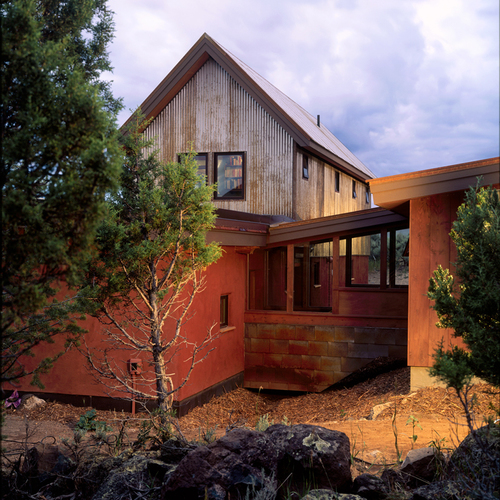
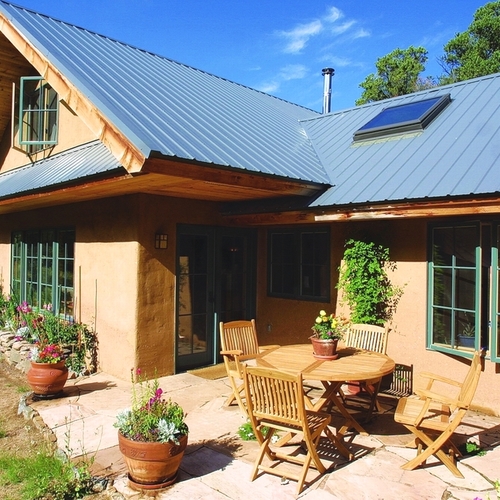
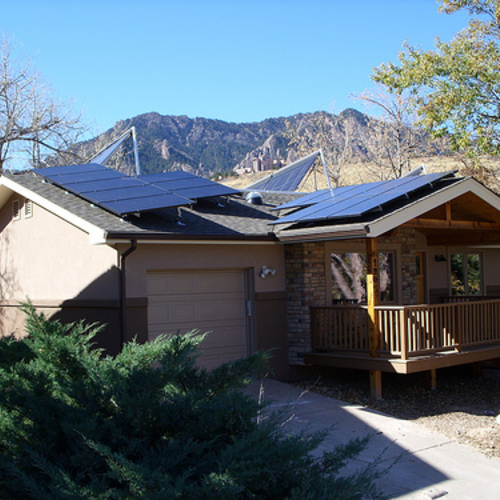
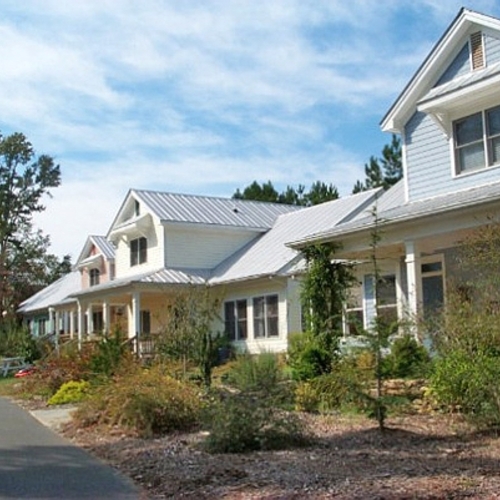






5 Comments
Checking on the true cost
This is certainly an admirable project and I very much appreciate the simplicity of the efficiency - fewer high priced/high tech products and lots of good, simple decisions. I would like to understand what the relative cost of this house if all the labor was included at market rates instead of donated student time. We need to see more projects like this completed with the structure of the marketplace.
This project illustrates a
This project illustrates a lot of good concepts that can be translated to any climate zone. Comfortable,Efficient and Affordable.
Some good ideas...
This is a useful case study. Even though the labor costs and overall house size aren't the most useful comparisons, there are a lot of interesting ideas here. Some of the concepts I'm now thinking about are solar water heating (are flat panels a better long-term value vs evacuated tubes??), 2x4 (24" oc)/2x6 (24" oc) with good insulation vs ICF/SIP's, Geotextile sand filters instead of standard septic laterals, and unvented roof with ductwork in conditioned space (how does that work?). Thanks for posting this project! I'm getting some great ideas from the case studies.
Home Remodeling
Thanks for this. Always looking for new approaches to green construction. The Geotextile Sand Filter system sounds like an impressive innovation. In my area lots are getting smaller and smaller as property prices rise, so any and all space-saving efficiencies are well appreciated. I'm going to check out the Eljen website right now! Thanks.
40,000 BTU furnace?
It seems to me that a home with 2x4 walls filled with dense pack cellulose and 1" of XPS foam on the exterior, located in Arizona, that is only 1200 square feet would not need a 40000 BTU furnace, particularly if attention was paid to the air barrier. Oversized, perhaps? Having said that, it is hard to find conventional furnaces manufactured with a lower BTU rating.
Log in or create an account to post a comment.
Sign up Log in